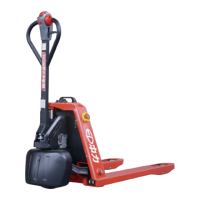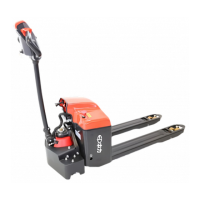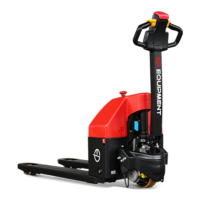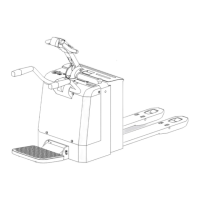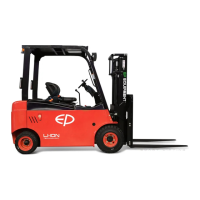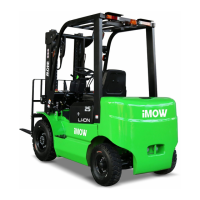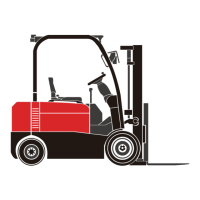What does PRECHARGE FAULT mean on EP Equipment Forklifts?
- JjenniferrodgersSep 9, 2025
A PRECHARGE FAULT on EP Equipment Forklifts suggests that the brake driver is shorted, the precharge circuit is damaged, or there is a MOSFET failure.
What does PRECHARGE FAULT mean on EP Equipment Forklifts?
A PRECHARGE FAULT on EP Equipment Forklifts suggests that the brake driver is shorted, the precharge circuit is damaged, or there is a MOSFET failure.
What to do if my EP Equipment EPL153 Forklifts load cannot be lifted?
If the load cannot be lifted on your EP Equipment Forklifts, consider these possible causes: * The charging capacity may be below 10/15%; charge the battery. * The truck may not be operational; carry out all measures listed under “Truck does not start”. * The hydraulic oil level might be too low; check the hydraulic oil level. * A fuse could be faulty; check the fuses.
What does THERMAL FAULT mean on EP Equipment EPL153?
A THERMAL FAULT on EP Equipment Forklifts indicates that the temperature is either greater than 80°C or less than -10°C. It could also be due to excessive load on the vehicle, operation in extreme environments, or the electromagnetic brake not releasing.
What does THROTTLE FAULT mean on EP Equipment Forklifts?
A THROTTLE FAULT on EP Equipment Forklifts suggests one of the following issues: the throttle input wire is open or shorted, the throttle pot is defective, or the wrong throttle type is selected.
What does SPEED POT FAULT mean on EP Equipment EPL153?
A SPEED POT FAULT on EP Equipment Forklifts indicates that the speed limit pot wire(s) are broken or shorted, or the speed limit pot is broken.
What does UNDER VOLTAGE FAULT mean on EP Equipment Forklifts?
An UNDER VOLTAGE FAULT on EP Equipment Forklifts indicates that the battery voltage is less than 17 volts or there is a bad connection at the battery or controller.
What does EE CHECKSUM FAULT mean on EP Equipment EPL153 Forklifts?
An EE CHECKSUM FAULT on EP Equipment Forklifts indicates an EEPROM failure or fault.
What does BATTERY DISCONNECT FAULT mean on EP Equipment Forklifts?
A BATTERY DISCONNECT FAULT on EP Equipment Forklifts means that the battery is not connected or there is a poor connection to the battery terminals.
What does BRAKE ON FAULT mean on EP Equipment EPL153 Forklifts?
A BRAKE ON FAULT on EP Equipment Forklifts indicates that the electromagnetic brake driver is shorted or the electromagnetic brake coil is open.
What does MAIN ON FAULT mean on EP Equipment EPL153?
A MAIN ON FAULT on EP Equipment Forklifts indicates that the main contactor driver failed closed.
Explains safety icons and text conventions used throughout the manual for clarity.
Provides access to the online parts manual via web address and QR code.
States the truck's compliance with EC Machinery Directive and relevant EU directives.
Defines the responsibilities and roles of the truck operator or user.
Outlines permitted applications and restrictions on truck modifications.
Details the truck's intended use, operating environment, and general specs.
Identifies and illustrates the main parts and assemblies of the truck.
Explains the buttons and levers on the control handle and their operations.
Describes the function of the key switch and the battery charging status indicator.
Details the purpose and operation of the emergency reverse button for safety.
Locates and identifies various labels and data plates on the truck.
Lists technical performance data and dimensions for the standard truck model.
Provides graphical representation and measurements of the truck's physical dimensions.
Covers pre-operation checks, workplace safety, and PPE requirements.
Guidance on maintaining a safe operating posture and hand placement.
Safety precautions for truck movement, including speed, loads, and inclines.
Essential safety rules for handling and charging lead-acid batteries.
Information on electromagnetic compatibility and its importance for truck operation.
Instructions for safely placing and securing the truck for transport.
Steps for first-time use and precautions during the initial operating period.
Rules for authorized personnel, prohibition of unauthorized use, and danger areas.
Step-by-step guide on how to start up and shut down the truck safely.
Explains how to drive, steer, and brake the truck using its controls.
Guidelines for safely approaching, lifting, and transporting loads.
Instructions for fork operation, secure parking, and load handling safety.
Precautions and procedures for ascending and descending slopes safely.
Procedures for attaching lifting equipment and installing the control handle.
A checklist for daily pre-operation inspection by the truck operator.
Fire protection measures and essential safety precautions when handling batteries.
Information on battery specifications and the procedure for charging the battery.
Step-by-step guide for safely removing and installing the truck battery.
Routine maintenance tasks and guidelines for storing batteries properly.
Regulations and precautions for transporting lithium-ion batteries.
General safety rules, use of spare parts, and disposal of materials.
Guidelines for qualified personnel regarding servicing intervals and checks.
A detailed checklist of maintenance tasks and their required intervals.
Identifies lubrication points and provides instructions for lubricant use.
Procedures for removing covers, adding fluids, and checking fuses for maintenance.
Steps for returning a truck to service after repairs or taking it out of service.
Requirements for regular safety inspections and guidelines for tire replacement.
Explains how to read and interpret error messages from the controller.
Guides on diagnosing faults using handheld units and LED indicators.
Explains safety icons and text conventions used throughout the manual for clarity.
Provides access to the online parts manual via web address and QR code.
States the truck's compliance with EC Machinery Directive and relevant EU directives.
Defines the responsibilities and roles of the truck operator or user.
Outlines permitted applications and restrictions on truck modifications.
Details the truck's intended use, operating environment, and general specs.
Identifies and illustrates the main parts and assemblies of the truck.
Explains the buttons and levers on the control handle and their operations.
Describes the function of the key switch and the battery charging status indicator.
Details the purpose and operation of the emergency reverse button for safety.
Locates and identifies various labels and data plates on the truck.
Lists technical performance data and dimensions for the standard truck model.
Provides graphical representation and measurements of the truck's physical dimensions.
Covers pre-operation checks, workplace safety, and PPE requirements.
Guidance on maintaining a safe operating posture and hand placement.
Safety precautions for truck movement, including speed, loads, and inclines.
Essential safety rules for handling and charging lead-acid batteries.
Information on electromagnetic compatibility and its importance for truck operation.
Instructions for safely placing and securing the truck for transport.
Steps for first-time use and precautions during the initial operating period.
Rules for authorized personnel, prohibition of unauthorized use, and danger areas.
Step-by-step guide on how to start up and shut down the truck safely.
Explains how to drive, steer, and brake the truck using its controls.
Guidelines for safely approaching, lifting, and transporting loads.
Instructions for fork operation, secure parking, and load handling safety.
Precautions and procedures for ascending and descending slopes safely.
Procedures for attaching lifting equipment and installing the control handle.
A checklist for daily pre-operation inspection by the truck operator.
Fire protection measures and essential safety precautions when handling batteries.
Information on battery specifications and the procedure for charging the battery.
Step-by-step guide for safely removing and installing the truck battery.
Routine maintenance tasks and guidelines for storing batteries properly.
Regulations and precautions for transporting lithium-ion batteries.
General safety rules, use of spare parts, and disposal of materials.
Guidelines for qualified personnel regarding servicing intervals and checks.
A detailed checklist of maintenance tasks and their required intervals.
Identifies lubrication points and provides instructions for lubricant use.
Procedures for removing covers, adding fluids, and checking fuses for maintenance.
Steps for returning a truck to service after repairs or taking it out of service.
Requirements for regular safety inspections and guidelines for tire replacement.
Explains how to read and interpret error messages from the controller.
Guides on diagnosing faults using handheld units and LED indicators.
| Brand | EP Equipment |
|---|---|
| Model | EPL153 |
| Category | Forklifts |
| Language | English |
